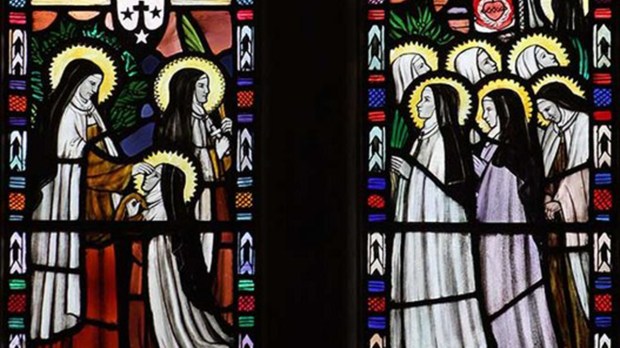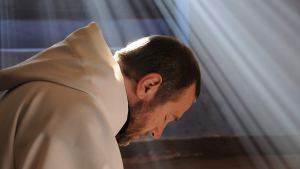The 16 Carmelite nuns of Compiègne could soon be canonized, with the so-called equivalent, or “equipollent” procedure, which recognizes devotion that is already established and perennial.
The nuns were guillotined on July 17, 1794, during the French Revolution and are known throughout the world thanks to the famous “Dialogues” that Bernanos dedicated to them, which in turn was based on Gertrud von Le Fort’s novel Die Letzte am Schafott (1931; The Song at the Scaffold), and was made into an opera.
In 2022, I.Media spoke with the coordinator of the file in France and with the postulator of the cause in Rome, as Pope Francis had given permission to submit the file to the Congregation for Saints’ Causes on January 20, 2022.
Now in 2024, there has not been any movement on the case, as the congregation still has the Carmelites in their queue.
Back in the 1990s, John Paul II was astonished before Bishop Guy Thomazeau, then Bishop of Beauvais — the diocese on which Compiègne depends — that the famous nuns had not yet been declared saints. The file has been bogged down several times, but was recently reopened when the bishop emeritus entrusted the task to Claire Millet, a secular laywoman in the Carmelite Order.
Months of efforts were finally ratified by the unanimous vote of the bishops of France at their fall assembly (November 2021). The present Carmelites of Jonquières-Compiègne, supported by all the branches of the Carmelite Order, then submitted their official request in December, obtaining a favorable response from the Pontiff a month later.
Why the “equipollent” procedure?
With the “equipollent” canonization, the inscription of the saints is done by a simple decree of the pope without the regular process, which involves verification of a miracle. Marco Chiesa, the postulator, explains that “they must have enjoyed a long and uninterrupted devotion, as well as a reputation for signs and graces.” Their canonization is requested by a large representation of the Church, directly to the pope.
Pope Francis has recognized a number of saints with equivalent canonization, including Peter Faber, Marie of the Incarnation, and Angela of Foligno.
Benedict XVI used the same recognition for St. Hildegard of Bingen, who is also recognized as a doctor of the Church.
Benedict XIV formalized this process in the 1700s. Through it, a pope invites the universal Church (as opposed to the local place where a saint might have been from, or a particular religious order he or she belonged to) to recognize the feast of the saint, with Mass and the Divine Office.
This recognizes that the Church’s judgment has been made on the person’s sanctity, even though the usual formula of canonization hasn’t been made.
This process is “an absolute novelty for our Order,” confides the Carmelite, who is in charge of drafting the “positio.”
“We work directly with the Dicastery for Saints’ Causes,” he explains, “seeking to document the uninterrupted devotion dedicated to the Blessed and their beneficial influence on the lives of the faithful, which is expressed in signs and graces.”
The procedure could now be quite fast, says Millet, who expresses the wish of Christians of France that the canonization could be celebrated at the reopening of Notre Dame de Paris in 2024. However, “the process is in its early stages,” the postulator cautiously moderates, “and it is difficult to know how long it will take.”
For the time being, a team working with the nuns of Jonquières-Compiègne is in charge of collecting and cataloguing the testimonies that are pouring in. “There is an incredible number of signs of piety, letters and emails from all over the world,” says Millet. “We just opened a Twitter address, and within 15 minutes of its opening there were 400 tweets requesting prayers and reactions! The same goes for Facebook. In Jonquières, in the current convent of the Carmelites, there is a whole floor of archives, which contains 15,000 signatures of petitions to ask for the canonization.”
A story of sacrifice for peace
“Their cause is known to the whole world, most probably through the script of Bernanos published in 1949,” Claire Millet emphasizes. Even if the writer took some liberties with the story, adding fictional characters, his Dialogues of the Carmelites was followed by an opera by Poulenc, films, and countless publications contributing to the worldwide fame of these nuns.
According to the Carmelite archives, the community’s sacrifice is to be understood in the light of a premonitory dream: “At the end of the 17th century,” says Millet, “a Carmelite nun from this convent saw her sisters ascending to Heaven carrying the Palm of the Martyrs. This has remained in the spiritual heritage of this Carmelite convent. In September 1792, in the midst of the Terror, the prioress interpreted this dream as a sign, proposing to the Carmelites to offer their lives, to make a consecration so that peace might be restored to the Church and to the State.”
After threats and denunciations in a climate of persecution by the Church, the nuns were taken from Compiègne to Paris by cart. They were brought before the Revolutionary Tribunal on July 17, 1794. Condemned, they were executed the same evening at 8:00 p.m. in the Place du Trône — today’s Place de la Nation — and their bodies were thrown into the Fosse commune de Picpus.
Their crime? “Fanaticism and sedition,” declared the public prosecutor. Their story made a lot of noise and became anchored in popular memory. Especially since, when they went up to the scaffold one by one, each of the nuns kissed a little statue of the Virgin held in her hand by their prioress. Before being guillotined in turn, the prioress gave the statue to the crowd, and it became a relic preserved and prayed before today in the crypt of the Carmel of Jonquières-Compiègne.
In the eyes of the Church, it is clear that the 16 Carmelites died “for their attachment to the holy religion. They did not want to renounce their faith,” emphasizes Millet. Recognized as martyrs, they were beatified on May 27, 1906, by Pope Pius X and their feast day was included in the liturgical calendar on July 17.
A heritage that bears scars
“They offered their lives, which gives meaning to their death,” insists Millet. This is the key message that makes this cause incredibly relevant today. They sacrificed themselves for Peace, which we all need so much today.
However, the issue remains delicate in the face of recuperations that would awaken the old scars of the French Revolution. The 16 nuns of Compiègne, says Fr. Chiesa, became martyrs “in the name of those principles that they were already living, but of which they were absurdly deprived: liberty, equality and fraternity.”
For the postulator, this reveals that “every ideology, whatever its form and origin, carries with it a trail of blood, as we still see today in the world, even if it does not make the headlines.”
Chiesa concludes, “Canonizing these 18th-century martyrs today is to encourage the hour of the saints, as Georges Bernanos spoke of: ‘It is sanctity, it is the saints who maintain that interior life without which humanity will degenerate until it perishes. […]. Without a doubt, one could believe that it is no longer the hour of the saints, that the hour of the saints has passed. But as I once wrote, the hour of the saints always comes.'”



